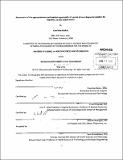| dc.contributor.advisor | Ernst R. Berndt and William Rodriguez. | en_US |
| dc.contributor.author | Rocker, Charlotte (Charlotte Amanda Lucy) | en_US |
| dc.contributor.other | Harvard--MIT Program in Health Sciences and Technology. | en_US |
| dc.coverage.spatial | n-us--- | en_US |
| dc.date.accessioned | 2012-09-13T19:37:27Z | |
| dc.date.available | 2012-09-13T19:37:27Z | |
| dc.date.copyright | 2012 | en_US |
| dc.date.issued | 2012 | en_US |
| dc.identifier.uri | http://hdl.handle.net/1721.1/72942 | |
| dc.description | Thesis (S.M.)--Harvard-MIT Program in Health Sciences and Technology, 2012. | en_US |
| dc.description | Cataloged from PDF version of thesis. | en_US |
| dc.description | Includes bibliographical references (p. 60-64). | en_US |
| dc.description.abstract | Hepatitis C (HCV) is the most common bloodborne infection in the United States. Although the incidence of HCV is declining, the burden of the disease is rising, driven by the increasing rates of end-stage liver disease and other consequences of advanced HCV infection. According to a 2009 report, the number of patients with advanced liver disease will quadruple over the next 20 years; in that time, total medical costs for patients with HCV infection are expected nearly to triple, from $30 billion to more than $85 billion. Given the limitations of current treatments and diagnostic technologies, HCV often goes undiagnosed and/or untreated. With new therapies in the pipeline that offer the promise of increased efficacy and improved side effect profiles, there likely will be a demand for improved diagnostics to more quickly and accurately identify patients in need of treatment. Daktari Diagnostics, Inc., based in Cambridge, Massachusetts, is developing a point-of-care, microfluidic diagnostic system that could be used both to diagnose HCV patients and to monitor treatment response. This thesis hypothesizes that Daktari's HCV diagnostic system can generate revenue in the United States, given the dynamics of the market. To explore this hypothesis, a background on the current diagnostic and treatment standards in HCV is presented, followed by an analysis of diagnostics and treatments currently in development. The thesis then defines the current paradigm of HCV testing and treatment and explores one potential future paradigm. Finally, a model of the HCV diagnostic market from 2012- 2019 is generated. This model demonstrates that, under conservative assumptions, the Daktari diagnostic system could generate a minimum of $25MM in revenue in the United States over its first five years on the market, from 2015-2019. | en_US |
| dc.description.statementofresponsibility | by Charlotte Rocker. | en_US |
| dc.format.extent | 64 p. | en_US |
| dc.language.iso | eng | en_US |
| dc.publisher | Massachusetts Institute of Technology | en_US |
| dc.rights | M.I.T. theses are protected by
copyright. They may be viewed from this source for any purpose, but
reproduction or distribution in any format is prohibited without written
permission. See provided URL for inquiries about permission. | en_US |
| dc.rights.uri | http://dspace.mit.edu/handle/1721.1/7582 | en_US |
| dc.subject | Harvard--MIT Program in Health Sciences and Technology. | en_US |
| dc.title | Assessment of the appropriateness and market opportunity of a point-of-care diagnostic solution for hepatitis C in the United States | en_US |
| dc.type | Thesis | en_US |
| dc.description.degree | S.M. | en_US |
| dc.contributor.department | Harvard University--MIT Division of Health Sciences and Technology | |
| dc.identifier.oclc | 809089545 | en_US |
